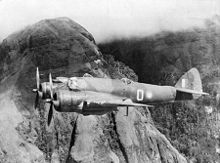- No. 30 Squadron RAAF
-
No. 30 (City of Sale) Squadron is a squadron of the Royal Australian Air Force (RAAF). Raised in 1942 as a fighter unit, the Squadron saw action in the Second World War and later served in the target towing and surface-to-air missile roles. After a long period of disbandment lasting from the late 1960s, No. 30 Squadron was re-raised as an airbase support squadron in July 2010.
Contents
History
No. 30 Squadron was established at RAAF Base Richmond on 9 March 1942 as a long-range fighter squadron operating the Bristol Beaufighter. After a brief period of training the Squadron deployed to Townsville where it escorted anti-shipping patrols. The Squadron was deployed to New Guinea in September, where it operated as a ground attack unit supporting the Allied efforts in Papua, a role in which the Beaufighter proved highly successful.
No. 30 Squadron's primary mission during the war was attacking Japanese shipping and coastal bases and in early 1943 the Squadron took part in the Battle of the Bismarck Sea. As part of the Australian First Tactical Air Force, No. 30 Squadron moved to Morotai in the Netherlands East Indies in March 1945 and supported Australian operations in Borneo. The squadron deployed to Tarakan in May 1945 and flew operations from that island in support of the Australian landing at Balikpapan. The Squadron returned to Australia in December 1945 on board HMS Glory and was disbanded on 15 August 1946.
No. 30 Squadron was re-formed at RAAF Base Richmond as No. 30 (Target Towing) Squadron on 8 March 1948. In this role the Squadron supported Army, Air Force and Navy training exercises and research conducted by the CSIRO. The Squadron was again disbanded on 21 March 1956.
An ex-30 Squadron Bristol Bloodhound missile on display at the RAAF Museum
On 11 January 1961 No. 30 Squadron was re-formed at RAAF Base Williamtown as a Surface-to-Air Guided Weapons Squadron equipped with Bloodhound missiles. In this role the Squadron provided air defence to the Sydney region and, from June 1965, to Darwin. The Squadron was disbanded again on 30 November 1968. To date, No. 30 Squadron is the only RAAF unit to have operated surface-to-air missiles (ground based air defence is currently provided by the Army unit 16th Air Defence Regiment, Royal Australian Artillery).
No. 30 Squadron was re-raised on 1 July 2010 as the unit responsible for providing airbase support services to RAAF Base East Sale. The squadron is designated No. 30 (City of Sale) Squadron and forms part of Combat Support Group.[1]
Aircraft operated
- Bristol Beaufighter (1942-1946, 1948?-1956?)
- Bristol Beaufort (1948?-1956?)
- Douglas C-47 Skytrain (1948?-1956?)
- CAC Wirraway (1948?-1956?)
- Avro Anson (1948?-1956?)
- CAC Mustang (1948?-1956?)
- Bristol Bloodhound SAM (1961-1968)
Notes
- ^ Lineham, Paul (24 June 2010). "Building up our cities". Air Force. http://digital.realviewtechnologies.com/default.aspx?xml=defencenews_airforce.xml. Retrieved 26 June 2010.
References
- RAAF Historical Section (1995). Units of the Royal Australian Air Force. A Concise History. Australian Government Publishing Service, Canberra.
- RAAF Museum 30 Squadron
Main series 1 · 2 · 3 · 4 · 5 · 6 · 7 · 8 · 9 · 10 · 11 · 12 · 13 · 14 · 15 · 20 · 21 · 22 · 23 · 24 · 25 · 26 · 27 · 28 · 29 · 30 · 31 · 32 · 33 · 34 · 35 · 36 · 37 · 38 · 40 · 41 · 42 · 43 · 60 · 66 · 67 · 71 · 73 · 75 · 76 · 77 · 78 · 79 · 80 · 82 · 83 · 84 · 85 · 86 · 87 · 92 · 93 · 94 · 99 · 100 · 102 · 107 · 292 · Fighter · Rescue and Communication · Seaplane · Berlin Air Lift
Article XV squadrons Joint Netherlands-Australian squadrons Categories:- RAAF squadrons
- Military units and formations established in 1942
Wikimedia Foundation. 2010.


